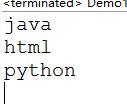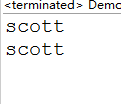其他容器
队列的实例1:
package othercollection;
/*
* 使用队列模拟银行存款业务
* */
import java.util.ArrayDeque;
import java.util.Queue;
public class Demo1 {
public static void main(String[] args) {
// TODO Auto-generated method stub
Queue<Request> queue = new ArrayDeque<>();
// 模拟排队情况
for (int i = 0; i < 10; i++) {
final int num=i;
queue.offer(new Request() {
@Override
public void deposit() {
// TODO Auto-generated method stub
System.out.println("第"+num+"个人办理存款业务,额度为:"+(float)Math.random()*1000);
}
});
}
dealWith(queue);
}
//处理业务
public static void dealWith(Queue<Request> que){
Request re=null;
while(null!=(re=que.poll())){
re.deposit();
}
}
interface Request {
// 存款
void deposit();
}
}
队列的实例2:
package othercollection;
/*
* 129 使用队列实现自定义堆栈
* */
public class Demo2 {
public static void main(String[] args) {
MyStack<String> history=new MyStack<String>(3);
history.push("www.baidu.com");
history.push("www.google.com");
history.push("www.taobao.com");
history.push("www.qq.com");
System.out.println(history.size());
String item=null;
while ( null!=(item=history.pop())) {//pollLast有取出并移除的功能
System.out.println(item);
}
System.out.println(history.size());
}
}
package othercollection;
/*
* 129 使用队列实现自定义堆栈
* */
import java.util.ArrayDeque;
import java.util.Deque;
public class MyStack<E> {
private Deque<E> container=new ArrayDeque<E>();
private int cap;
public MyStack(int cap) {
super();
this.cap = cap;
}
//实现进栈
public boolean push(E e) {
if (container.size()+1>cap) {
return false;
}
return container.offerLast(e);
}
//出栈
public E pop(){
return container.pollLast();
}
//获取
public E peek(){
return container.peekLast();
}
public int size() {
return this.container.size();
}
}
Enumeration
枚举,作用和Iterator类似,都是输出数据
方法:
- hasMoreElements()
- nextElement()
实例:
package otherenumeration;
import java.util.Enumeration;
import java.util.Vector;
/*
* 130 Enumeration的使用
* - hasMoreElements()
- nextElement()
* */
public class Demo1 {
@SuppressWarnings("rawtypes")
public static void main(String[] args) {
// TODO Auto-generated method stub
Vector<String> v1=new Vector<String>();
v1.add("java");
v1.add("html");
v1.add("python");
Enumeration en= v1.elements();
while (en.hasMoreElements()) {
System.out.println(en.nextElement());
}
}
}
Hashtable
一:和HashMapd 区别:
1.Hashtable线程安全,同步,效率相对低
2.Hashtable的父类:Dictionary。HashMapd是AbstractMap
3.null : Hashtable的<k,v>都不为空
HashMapd的k最多一个null,值可以多个null
二:Properties
1.作用:读写资源配置文件
2.kv只能为字符串
3.方法:
setProperties(String key,String value)
getProperties(String key)
getProperties(String key, String defaultValue)
package properties;
import java.io.File;
import java.io.FileNotFoundException;
import java.io.FileOutputStream;
import java.io.IOException;
/*
* 131 使用Properties输出到文件
资源配置文件:
1. .properties
store(OutputStream out,String comments)
store(Writer w,String comments)
2. .xml
storetoXML(OutputStream os,String comments)
storetoXML(OutputStream os,String comments,String encoding)
* */
import java.util.Properties;
public class Demo02 {
public static void main(String[] args) throws FileNotFoundException, IOException {
// TODO Auto-generated method stub
Properties p1=new Properties();
//存储
p1.setProperty("driver","oracle.jdbc.driver.OracleDriver");
p1.setProperty("url","jdbc:oracle:thin:@localhost:1521:orcl");
p1.setProperty("user","scott");
p1.setProperty("pwd","935743");
//获取
String url=p1.getProperty("url","test");
System.out.println(url);
//存储到H:\\1\\(绝对路径)
p1.store(new FileOutputStream(new File("H:\\1\\db.properties")),"db配置");
p1.storeToXML(new FileOutputStream(new File("H:\\1\\db.xml")), "db配置");
//存储 (相对路径)
p1.store(new FileOutputStream(new File("src/db.properties")),"db配置");
}
}
package properties;
import java.io.FileNotFoundException;
import java.io.FileReader;
import java.io.IOException;
import java.util.Properties;
/*
* 131 使用Properties读取资源配置文件
*
* */
public class Demo03 {
public static void main(String[] args) throws FileNotFoundException, IOException {
// TODO Auto-generated method stub
Properties p2=new Properties();
//读取绝对路径
p2.load(new FileReader("H:\\1\\db.properties"));
System.out.println(p2.getProperty("user","test"));
//使用相对路径读取配置文件
p2.load(Demo03.class.getResourceAsStream("/db.properties"));
p2.load(Thread.currentThread().getContextClassLoader().getResourceAsStream("db.properties"));
System.out.println(p2.getProperty("user","test"));
}
}



